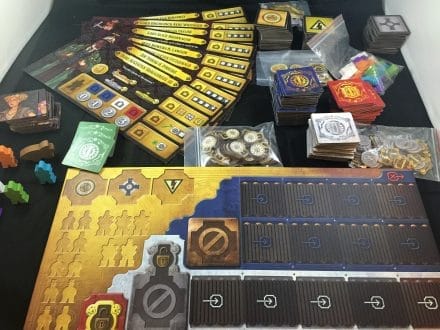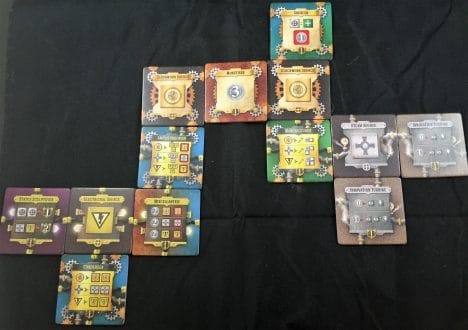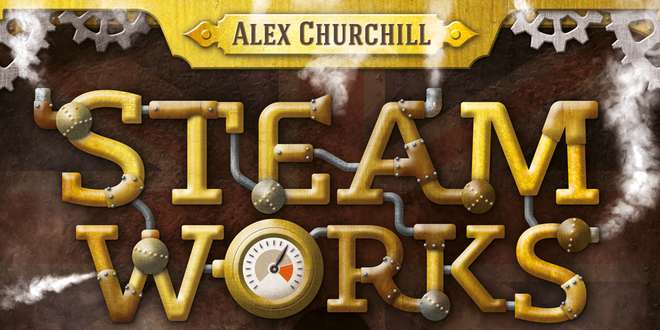Hello, TechRaptor readers. It’s time to bounce back to board games and take a look at Steam Works, a steampunk-themed European-style board game from Tasty Minstrel Games. You’ll be building contraptions, using your contraptions (and other players’ contraptions), and trying to make the most stupendous contraptions to garner the most Prestige and impress Queen Victoria. This is a game with a steep learning curve that is easily understood once you grasp the basics but will take much longer to truly master.

There’s a lot of moving parts in the game (pun unintended), and the manual unfortunately does a poor job of explaining just how the game works for first-timers. My wife and I read through the rules about three times each trying to decipher it before ultimately throwing our hands up in exasperation and searching YouTube for answers. And even after doing so, we were constantly referring to the rulebook to confirm various points and mechanics.
Another failing in the instructions department is the single reference sheet for the tiles. The game relies heavily on pictographs to explain what each specific tile and action is supposed to do. In and of itself that is perfectly fine once you get the hang of it and learn to recognize the more common ones. The problem with this approach, however, is that the only reference available is the single copy in the instruction booklet. Your first few games will have a good amount of time allocated to passing the booklet around and trying to figure out just what everything actually does. Including separate reference sheets for each player, even for just the tiles, would be a huge improvement and would remove a large barrier to getting new players involved in the game.


At its core, gameplay is deceptively simple. Players choose which character they would like to be and choose which side of the persona card they would like to use; each player gets to choose the side they prefer. Each player then gets a set number of workers and actions. Players can either activate one of their abilities on their card or activate one of the constructed devices currently on the table via an available paid-for worker and follow through with whatever said contraption actually does. Not only can you activate one of your own creations, you can also activate another player’s device as well. Doing so offers a small reward to the owner, so there’s a layer of strategy involved in doing so. It has less of an effect in the early game, especially if someone else has a builder or an Upgrader on the table. Late game, however, it becomes a completely different story as you’re trying to acquire enough prestige to win and want to avoid giving your opponents any more Prestige than absolutely necessary.
Activating these creations can have multiple results, depending on how complex they are. While most characters have an ability to build a device without needing a constructor, this tends to be rather limited in use throughout the game as a whole. Each character has a specialty that can dictate just what they can build and how it can be powered. Playing as a character who can build devices powered by electricity, for example, isn’t very useful in the beginning stages of the game but quickly becomes valuable as the game progresses. Conversely, being able to build devices powered by clockwork energy can give you a quick head start in the beginning but will ultimately become less useful as new components require either steam or electricity to utilize.

Another interesting mechanic in Steam Works revolves around first turn order. During each round, the player going first changes, giving everyone a chance to activate any the inventions currently in play regardless of owner. While this may not be such a big deal in smaller games, it can be a game-changer if there is only one Constructor or Upgrader currently on the board. And if someone has an invention that will generate Prestige, it will be a prime target towards the end game when the mad scramble for Prestige and the finish line begins.
The game is split up into three phases, called “Ages." The phases change once a set amount of prestige (or money, if you’re playing with only two people) runs out, ensuring a fairly quick pace. The components coming off the conveyor belt become more powerful and require more resources to use. The new components will also be worth more prestige as well, meaning players who spent the beginning portion of the game building Constructors and Upgraders will have the opportunity to surge ahead of everyone else. At the end of the game, players add up all the Prestige they’ve earned, and the player with the most is considered the winner.
When you sit down to play this game, one factor that should be considered seriously is table space. Even with just two players, Steam Works will easily devour table space with little effort as you either build new inventions or expand your current creations. Keeping everything separate can be difficult if you’re playing on a coffee table or a small dining room table when you add in character sheets, components on hand, and inventions. The end result is rather impressive to behold, especially when you start taking stock of what every player currently has available and start mentally working through the end result of activating your primary target device. Just make sure you have enough room for everything else. While game size is not a major concern if you have a dedicated gaming space, it does make playing through your first few times rather daunting. This along with the constant passing of the rule book to figure out exactly what your components do make the game rather difficult to introduce new players to and will try the patience of some veterans jumping in.
Overall, the game is a well-crafted and enjoyable European-style board game with a unique theme and mechanics that is somewhat marred by muddy instructions, a too-strong reliance on pictographs, and only a single copy of the glossary. If you like Euro games and are willing to resort to YouTube tutorials, Steam Works is an excellent addition to your library. If you aren’t a big fan of the European style of gaming, I’d give this game a pass.
The Good:
- Unique theme and artwork
- Fast-paced gameplay
- Multiple layers of strategy to consider
The Bad:
- Confusing and hard to follow rule book
- Only one copy of component glossary
- Requires large table space
The copy of Steam Works used for this review was generously provided by Tasty Minstrel games.
Review Summary
A fast-paced, complex game of resource management and activation order marred only by the constant need to reference the rulebook.
(Review Policy)Have a tip, or want to point out something we missed? Leave a Comment or e-mail us at tips@techraptor.net













